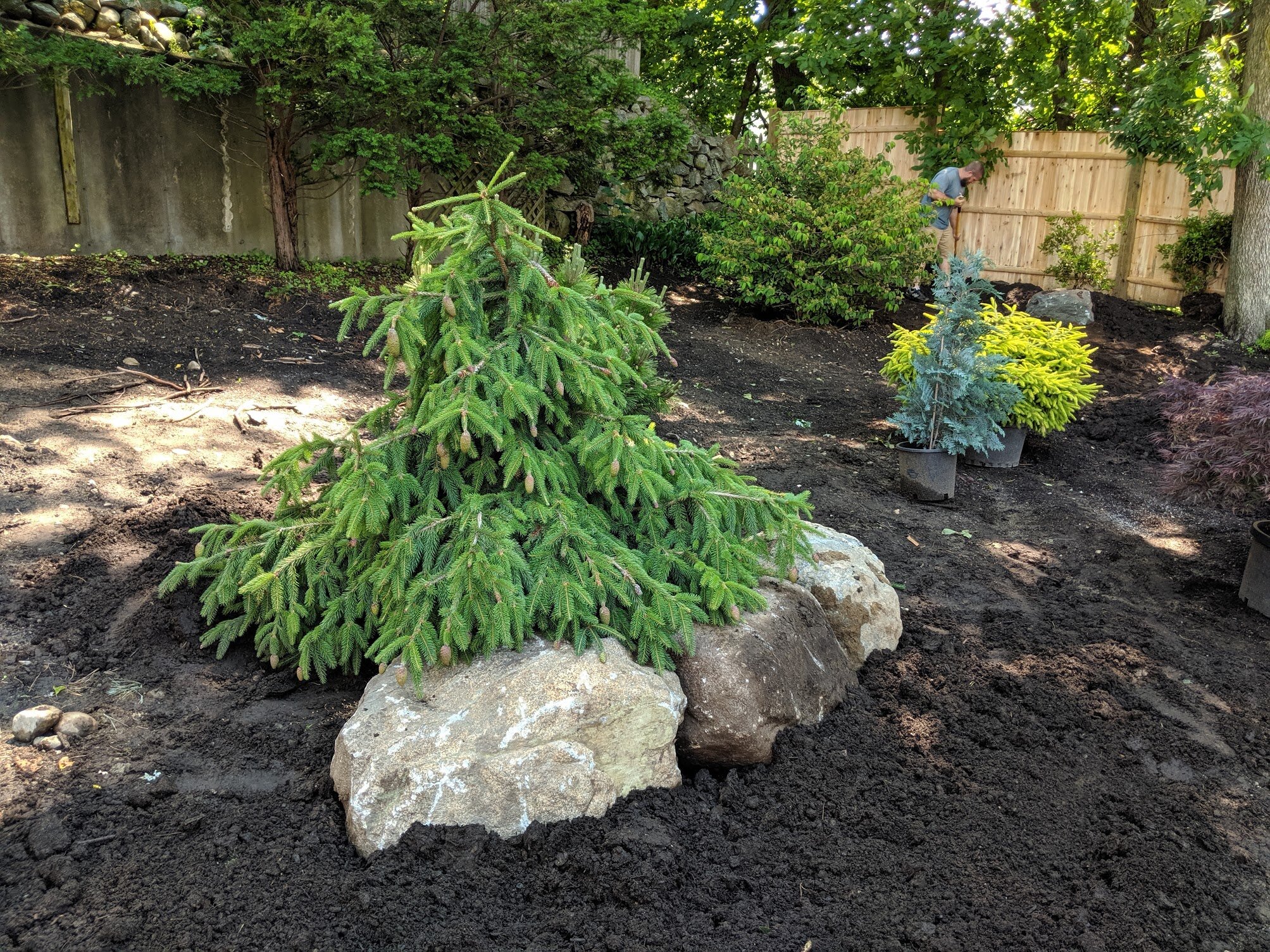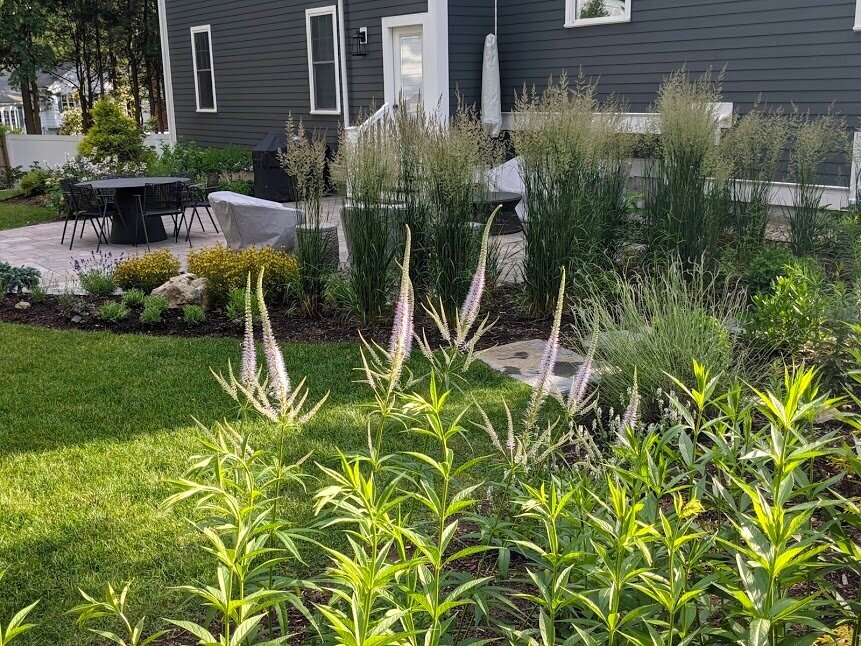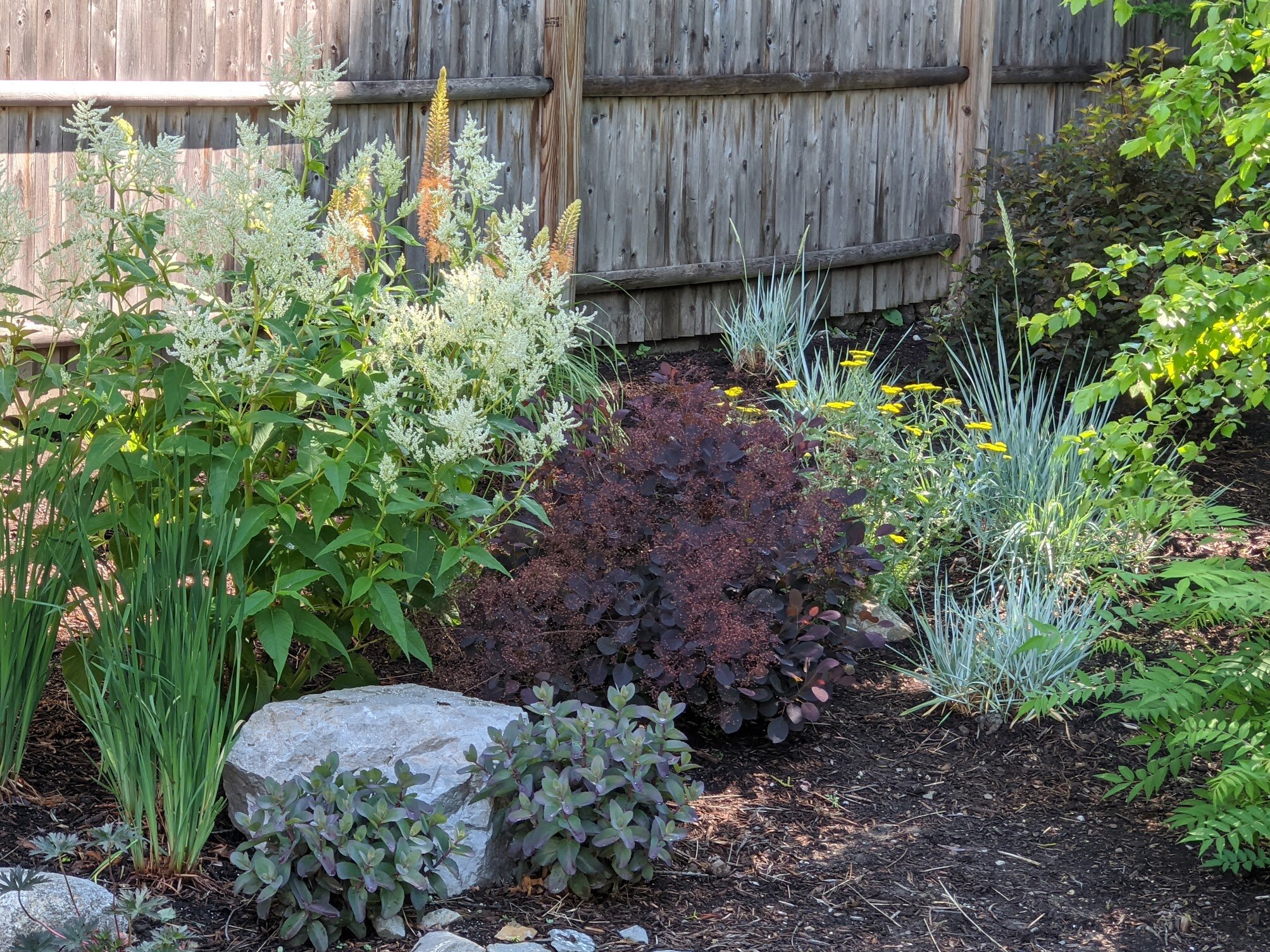extreme garden makeover, arlington, ma, 2019-2022
This multi-year makeover of an out-dated and non-descript landscape into a highly textured and biodiverse garden was by far the most extensive project of my gardening career. Looking back on it, had I known at the time just how challenging and extensive it was going to be, I may have declined the opportunity. Thankfully, I didn’t. And my good friends Pauline & Lorenz were wonderful to work with as we transformed their backyard into a graceful plant haven and outdoor living space worthy of their beautiful Arlington home. This garden evolves annually under the careful Stewardship of Pauline and Lorenz.
october, 2018: planning for a real garden
A primary goal was to create privacy on the 3 sides of the garden with visually stunning vignettes viewable from the inside as well as the outside of the house. Large windows look out from the kitchen and dining room onto the property, making four season interest a priority. So, a mixed border of green, gold and blue conifers were identified to combine with maroon leaf deciduous trees. Pollinator plants were important, of course, and the general goal was to create a biodiverse habitat for all wildlife (read more on just how successful we were below). We also agreed it important to retain a good amount of lawn to accommodate social gatherings and games.
First, we identified a handful of their existing plants to be repurposed elsewhere in the garden, leaving 90% of the plant material to be removed. This was a case of addition by subtraction. Once the borders of hosta and daylilies were eliminated, we could begin the intensive design process of layering in trees, shrubs, grasses, perennials and groundcovers.
Theirs is a huge backyard for Arlington, and its long, narrow geometry presented many opportunities as well as challenges along the way. Luckily, my friend, Bill Parker of Parker Garden Design, was involved from the outset and was instrumental in the preparation of the site, the building of a larger patio, and the installation of the Phase One plant material. Bill also coordinated installation of a drip irrigation system with Smart Water Irrigation, as well as installation of beautiful sod and heavily aged compost/mulch for the finishing touches.
It was my job to work with the owners on the overall design and plant selection and then to curate the material for the Parker crew to install. Bill’s crew once again proved why their services are in such demand. Their professionalism and expertise in every step of the project made my life so much easier. The ‘before’ photos that follow reveal the opportunities for improvement yet to unfold.
june, 2019: the rehabilitation begins
While a local fence company upgraded the east side fence, the Parker Garden Design team got to work clearing out the property and digging the dry wells to receive rainwater from the downspouts that had been threatening the foundation and surrounding plant material. The two new dry wells will effectively eliminate these water management issues!
june, 2019: tree & plant deliveries
A month prior, the clients and I had previously visited New Hampshire wholesale suppliers Millican Nurseries and Van Berkum Nursery to hand pick our trees, shrubs, grasses and perennials. Many more shopping trips occurred throughout the summer as this project sucked up plant material like a sponge!
patio upgrade: july, 2019
Now that the dry wells are complete, one Parker Garden crew tackles patio removal and reconstruction while the other tackles tree and plant installation.
creating instant privacy and structure with trees: july, 2019
Once all old plant material has been removed, the Parker Garden crew applies a generous layer of high quality garden soil in the new curvaceous beds. And the exquisite new ‘bone’s of the garden are installed, creating a foundation upon which to build the layered palette of unusual grasses and perennials.
Phase one installation of grasses and perennials: July, 2019
The oppressive heat of July made this project extremely uncomfortable, with temps frequently approaching 100 degrees with high humidity. But the Parker Garden crew soldiered on and were planting machines, always smiling, never complaining. Once everything was in place, drip irrigation was installed, followed by a generous layer of Nutri-mulch to reduce evaporation and weeds. The final step of new sod is all that is needed!
the garden survives despite heat and rabbits: august-October 2019
The original decision to plant grass seed was overturned in favor of sod, so the clients could immediately enjoy and explore their long awaited garden. The sod shrugged off the extreme heat and adapted beautifully, its emerald green accentuating the luscious curves of the garden. Most of the perennials adapted quickly, as well. Even the Karl Foerster grasses that were looking a bit worse for wear from the dry heat took hold and had expanded their crowns by summer’s end.
Alas, almost immediately, the garden was under attack from voracious rabbits. I guess they approved of our planting scheme for not only shelter, but for dinner. They sampled almost everything and quickly leveled echinacea, rudbeckia, lobelia, liatris, yarrow, grasses and more. Just this past winter, they devoured the bottom 18” of the gorgeous Serbian Spruce tree! We are gradually learning what they won’t eat and how to deter them with certain plant combinations, but it’s an ongoing struggle. Waskly wabbits!
second year splendor: June-October, 2020
Throughout the summer of 2020, Pauline, Lorenz and I continued to introduce more plants and small trees to build height and to fill gaps left by the rabbits. Some specimens were relocated from the front of the house to this backyard garden where they are now much happier.
This project required a lot of effort to build in all the layers and to get the rhythm of shape, form, texture and color just right for the sensibility of each garden vignette. But it’s been so much fun and so rewarding to see this garden come alive. In a short time it has performed beyond our expectations, providing a visual feast as well as essential wildlife habitat for birds, bees, butterflies, a rafter of turkeys, and of course the bunnies, chipmunks and squirrels. (click to enlarge photos and to reveal plant names; click the side of image to advance right and left through the gallery)
2021-2022 spring scenes
As the garden matures and additions are made, the garden has taken on a more naturalized look. Plants are fuller and looser, with few margins in between. It has become an oasis of biodiversity just outside Boston.





























































































